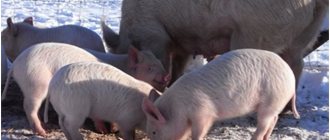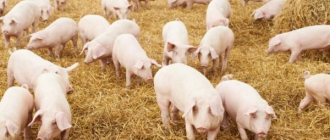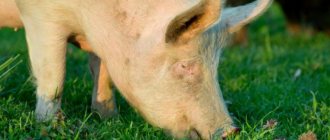Duration of pregnancy
The healthiest pigs are allowed to breed.
A pig's pregnancy (gestation) normally lasts 114 days. Individual females may have individual deviations in the gestation period of several days, up or down.
Primiparous sows, especially those bearing many piglets, give birth earlier: birth can occur in the period from 105 to 110 days.
The phenomenon is explained by the insufficient readiness of the uterus of a young female to carry piglets to term. However, the offspring will be strong if the animal is healthy.
Some first-born pigs can significantly progress through pregnancy, giving birth to piglets on the 120th day, which is not a dangerous deviation.
Preparatory activities
Calendar for calculating the day of farrowing
A pig's pregnancy lasts on average about 115 days. But at this time, only a quarter of the pigs will pigs. A deviation of several days up or down is not an anomaly.
The pig farrowing calendar will tell you the approximate date of birth. In the table, select the date and month of insemination. From the indicated day, monitor the condition of the woman in labor and be prepared for the start of farrowing. Labor should begin in the next 1.5 weeks.
Pig farrowing calendar
But it is impossible to determine the date with an accuracy of one day even using a sow farrowing table. The period is influenced by the conditions of detention and the state of the animal’s body.
Also, farrowing of pigs for the first time often begins as early as 105 days. And for experienced pigs, pregnancy lasts longer.
Preparing the pigsty
It is important for the pig to feel comfortable during delivery. Farrowing should take place in a place familiar to the female. It is advisable to temporarily move other pigs into a separate room.
A few days before the expected farrowing date, carry out a general cleaning of the pigsty. Wash all surfaces with an alkaline solution (100 g per 0.5 liter of hot water), and treat the walls and ceiling with slaked lime.
Be sure to fill the bowl with clean water. The pig experiences extreme thirst during farrowing and may attack the offspring.
Place clean straw or wood bedding. Provide a flow of fresh air, but without drafts. The optimal temperature is 18-25°C. When it's cold, put on a heater. If the birth takes place in extreme heat, spray the pig with cold water from a spray bottle every 10-15 minutes so that she does not suffer from the heat.
Set up a house for the piglets in advance. Maintain a temperature of 29-30°C using infrared lamps so that the babies dry quickly and do not freeze.
It is also advisable to install a maternity cage for the sow in the pigsty. Introduce a pregnant pig into it a couple of days before giving birth. This measure will prevent injury to the offspring. Sows usually lie against the wall, press their babies against it and can crush them. In the maternity cage, the female will stay close to the piglets, but will not harm them.
Stocking up on inventory
Place things in the pigsty in advance that may be needed during childbirth. You will need:
- sterile gauze;
- cotton wool;
- antiseptic;
- enema;
- potassium permanganate solution;
- syringe;
- scissors;
- boiled water;
- oxytocin;
- strong threads.
If the pig cannot give birth on her own, obstetric forceps will be needed. But only use them if you have experience. Otherwise, it is better to invite a veterinarian in advance or be in touch with him.
How to determine the farrowing date?
Farrowing time is easy to determine. They take a calendar, mark the exact date of mating, count down 114 days and get the approximate date for the appearance of the offspring.
The pig breeder should begin to especially carefully monitor the condition of the pet from the 100th day after mating. From this time on, the sow is moved to a separate pen where she will give birth and will be kept with her piglets.
The approach of farrowing is accompanied by signs, knowledge of which helps farmers raising pigs to determine the situation.
Farrow date calculation and calendar
The date is calculated using a farrowing calendar. It is convenient to keep an individual sow calendar, noting the characteristics of the animal. During primary farrowing, they are guided by the average gestation period.
Pig pregnancy calendar
Registration of matings and calculation of farrowing date
All matings must be taken into account, otherwise it is impossible to determine the farrowing date. The best fertility of nulliparous domestic pigs is observed after 4 hunts without mating. The weight of the female must be at least 120 kg.
When keeping several sows, maintaining a breeding calendar is mandatory: in the absence of records, remembering and tracking the start time of farrowing for each pig is almost impossible.
Be sure to read:
How long does a pig's pregnancy last, determining the farrowing date
It is more convenient to organize spring farrowing, for which mating is carried out in early December. In this case, the piglet will grow under favorable weather conditions.
Behavioral signs of impending labor
The behavior and external changes of the pig tell the owner that farrowing is approaching.
Before giving birth, the pig often lies down
Signs of imminent labor are bright and characteristic:
- Descent of the belly. The phenomenon can be noticed by sagging of the lower back, which makes the back uneven.
- Careful movements. The sow stops moving quickly and abruptly.
- Swelling of the genital slit. Usually develops one day before farrowing.
- Colostrum secretion from enlarged nipples. Observed the day before the birth of piglets.
- Preparing the nest. On the eve of the birth of the offspring, the female begins to prepare the place, raking the litter into a heap.
- Discharge of mucus from the genital opening. This sign is observed simultaneously with rapid breathing, frequent changes in position - the animal lies down, stands up. The birth of piglets is expected in the coming hours.
Important! Most pigs give birth at night.
Preparing for farrowing
Knowing the date of birth of the pig and the approximate date of delivery, you need to take care in advance about the room where farrowing will be carried out, equipment, and calling a veterinary specialist.
As a rule, the animal is transferred to an individual dry and clean pen. It should have optimal artificial and natural lighting. If a pig piglets in winter, the room must be additionally insulated (the optimal temperature is 18-20 degrees) and care must be taken to ensure that there are no drafts.
Preparing the room
The queen cell should be prepared no later than 6 days before farrowing, removing all unnecessary material. The following types of work must be performed indoors:
- Disinfect floors, walls, ceilings. This is necessary to exclude diseases of the uterus and offspring. Prepare a disinfectant solution at the rate of 100 grams of alkali per 500 grams of hot water. They wash everything inside with it, then whitewash the walls and ceilings with slaked lime.
- Change the bedding. To provide the sow with optimal conditions for giving birth, you need to cover the floor with dry straw.
- Prepare a place for the offspring. In rooms that are not heated in winter, an insulated corner with a covered top is built for future offspring. It is necessary to hang a lamp (preferably infrared) in it - it will compensate for the lack of heat for the piglets. The nest should be covered with a thick layer of dry straw.
- It is advisable to install a metal drinking bowl - it is more hygienic than a wooden one. Subsequently, do not forget to change the water regularly; there should be plenty of it.
Preparation of tools
A veterinarian cannot always be present when a pig is farrowed in a private farmstead. In order to prevent possible complications, you need to make sure that at the right time you have on hand tools and other essential devices and at least a minimum of aseptic preparations:
- dry diapers;
- iodine or brilliant green;
- gloves;
- cord and scissors;
- hot water.
To help the sow farrow (rarely, but it happens that the animal cannot do this on its own), you need to have special veterinary equipment for farrowing:
- universal tongs;
- hook;
- obstetric loop.
All listed instruments must be sterilized. You need to prepare boiled water, wash your hands up to the elbows, and put on rubber gloves. As soon as the first signs of labor appear, you need to wash the pig’s underbelly along with its teats. All this will help avoid infection.
How long to wait for piglets, is it possible to influence this?
The number of piglets can be affected by the age of the pig, quality of food, living conditions, general health, and breed
. Pigs are prolific animals. The first farrow usually produces 6 – 8 cubs. A mature female, who has given birth more than once, can have up to 16 piglets.
Interesting! The quantity can be affected by the age of the pig, quality of food, living conditions, general health, and breed.
An animal that is provided with optimal conditions usually produces the maximum number of offspring.
The owner influences the number of piglets indirectly by maintaining the health of the sow. A pig giving birth for the first time does not produce a large litter, even with ideal maintenance.
Time of year for mating
The optimal time for mating pigs is November-December.
Piglets born in the spring are stronger, grow faster, and are less susceptible to disease. Gestation in winter proceeds normally if the sow is well fed and kept in a sufficiently warm room with light.
Sow farrows for the first time
Pig reaches sexual maturity at the age of 6 months. At this moment, they usually experience their first heat (increased sexual excitability, the female’s body is maximally tuned to procreation).
Important! It is advisable to plan mating so that delivery coincides with the most favorable time of year for raising young animals.
But their body has not yet fully formed to bear offspring, so the first mating can only be carried out under the following circumstances: the pig has reached the age of 10 months, its weight is 100–130 kg. The presence of these conditions will allow the sow to normally bear and give birth to healthy, strong offspring.
The following moments will indicate the onset of estrus:
- anxiety;
- refusal of food;
- jumping on neighbors;
- swelling of the vulva;
- increased amount of vaginal discharge.
When these messengers are detected, the female is covered.
The excitability usually lasts 24–48 hours. During this period of time, you need to have time to carry out at least two matings. The first attempt is made 12–18 hours from the moment the first signs appear; the boar is re-launched to the female after 12–15 hours. If after 21 days sexual excitability does not recur, then everything went well - the female is pregnant, and soon we can expect a new addition to the family.
Read more about pig mating.
How does a pig farrow?
Farrowing in most cases does not require intervention. The pig gives birth lying on its side, “shooting” the piglets. The owner must monitor the process in order to help the sow or newborn pig if necessary.
First, piglets are born from one horn of the uterus, and then from the second. The interval between the birth of the first piglets is minimal, then the intervals increase, amounting to about half an hour. The last cub sometimes appears after a break of 40-50 minutes. Childbirth lasts from 2 to 10 hours.
How a pig gives birth
Initially, the sow experiences contractions that gradually increase, turning into pushing. The animal behaves restlessly and squeals. The first-born female may be frightened by contractions; the owner needs to calm the pet down.
Be sure to read:
How to find out the weight of a pig without scales: table, methods of determination and calculations
After copious mucus leaves the genital slit, the pig lies on its side. The piglets, thickly covered with mucus, easily leave the mother's body, flying out. The pig seems to shoot its cubs.
Human assistance during farrowing
Piglets are born covered with a layer of mucus, so babies should be wiped with a soft cloth, mouth and nose cleaned. The umbilical cord is cut off at a distance of 5-6 cm from the abdomen.
Human assistance during farrowing
The remaining part of the umbilical cord is lubricated with iodine to prevent infection. Treated piglets are placed under a heat lamp away from the laboring mother, as it can damage them during birth.
Advice! In extreme heat, it is recommended to pour cool water over the giving birth sow to stimulate labor.
How many piglets does a pig produce?
The number of piglets born to a sow is determined by the breed of the animal, age, and living conditions. Large sows who have not had their first farrow produce up to 16 cubs.
Breeds from the mini pig category produce up to 6 cubs. Primiparous females of large breeds give birth to 6-8 cubs, and mini-pigs - only 3-4 piglets. When purchasing a pig for breeding, you should find out about the fertility of the mother of the selected animal.
Childbirth technique
A healthy, strong female piglets without the help of her owners. But you still need to constantly be nearby and understand how a pig gives birth in order to identify problems in time.
Babies emerge from the birth canal with their head or hind limbs forward. In the second case, the pig sometimes gets stuck. Pull it gently by the legs, but do not yank sharply. If you miss time, the piglet will suffocate.
In sows, the cervix sometimes dilates poorly. Therefore, the birth canal is not moist enough, and active attempts remain ineffective. Heat the water and pour it into the genital tract using an enema for 10 minutes, then massage the cervix with your finger.
Sometimes more than 20 minutes pass after the last piglet appears, and the next fetus does not come out. Put on a medical glove, treat it with any antiseptic and generously lubricate it with Vaseline. Carefully insert your hand into the vagina and feel the fetal leg. Start to pull it out slowly, but only while pushing.
The pig should be helped by the person he trusts. Otherwise, she may not let him near her, and the piglets will be born dead or die in the womb.
The amniotic sac usually bursts before birth. But sometimes piglets are born “with their shirts on.” Immediately pierce the shell with scissors so that the baby does not suffocate.
After the baby is born, cut its umbilical cord at a distance of 5 cm, then tie it and cauterize it with iodine. Wipe the baby's body with sterile gauze, clean the nostrils and mouth. After this, place the piglet under an infrared lamp to prevent it from catching a cold.
Remove the afterbirth immediately after it appears. If a pig eats it, it may later attack the piglets.
What to do after farrowing
The sow should not be allowed to eat the placenta: the piglets will then swallow it. If the placenta does not pass for more than 5 hours, you must call a veterinarian.
Feeding newborn piglets
Caring for a farrowed pig comes down to the following:
- washing the area of the female’s genital slit with warm water, wiping with a dry cloth;
- changing contaminated litter;
- providing the animal with the constant presence of drinking water;
- giving the chatterbox 9-10 hours after farrowing;
- monitoring the sow so that she does not crush the piglets (if the pig is careless, the offspring are placed next to her to eat, and then put into a cage).
An inexperienced pig farmer should invite a veterinarian to examine the female and piglets. It is advisable to have a specialist present during farrowing.
The sow does not allow the piglets: what to do
Young pigs may refuse to nurse due to nipple sensitivity and the piglets' strong grip. The problem also appears with inflammation of the mammary glands, when feeding causes pain.
The decision when a pig refuses to feed piglets depends on the reason, which is easier to determine if you involve a specialist. Sometimes the offspring have very sharp teeth that damage the sow's nipple, in which case they need to be filed down.
Why doesn't a pig eat after farrowing?
A pig's refusal to feed after the birth of piglets can be associated with damage to internal organs, inflammation, or parts of the placenta remaining in the uterus or dead piglets.
Be sure to read:
Do-it-yourself castration of piglets: preparation, stages of operation and care
The animal is offered sweet water. If the pig refuses, then call the veterinarian. The norm is a lack of appetite in the animal in the first 9-12 hours after the birth of the offspring, which is associated with severe fatigue.
A sow may also lose her appetite if she is constipated. This phenomenon is not uncommon. It is important to eliminate it as soon as possible, otherwise the animal will weaken; and the milk that piglets suck will reduce the quality, which will negatively affect their growth.
Farrowing and human assistance in this process
How is farrowing done?
The uterus of an animal consists of two birth canals or “horns”. With each push, a pig appears and the water breaks. The birth of piglets occurs in strict order: first from one horn, then from the other. The paired connection of the placenta is characteristic.
There is a short period of time between the appearance of the first and second cub - only 5-7 minutes. Other piglets are born an average of 20 minutes apart. The last two piglets take the longest to be born.
Help for a primiparous sow
The most difficult farrowing is for pigs bearing offspring for the first time. Often a person has to assist them in this process.
When a piglet appears in the mother’s genitals, you need to accept it and break the amniotic sac, if it has not burst itself, otherwise the newborn may suffocate.
If you remain in the shell for some time, cardiac and respiratory arrest is possible. In this case, the following resuscitation actions are carried out:
- Chest massage. Also, with sharp, but not strong movements, they hit the piglet on the face and sides with the palm of their hand. Perform these steps for two minutes.
- Artificial respiration. If the first option is unsuccessful, use the mouth-to-mouth method using a cloth folded in 2-3 layers.
- Water therapy. A piglet without signs of life is placed in water heated to 45 degrees, immediately removed and lowered into a bucket of water at room temperature.
If the amniotic fluid breaks prematurely, the sow needs to be artificially injected with an oily fluid into the birth canal. For these purposes, a decoction of flax seed or sunflower oil, which is first boiled and cooled, is suitable. If the cervix does not dilate for a long time, warm water is poured into the birth canal to speed up the process.
When a pig is born, it is mandatory to wipe its body dry, clear its nasal passages, and remove any remaining mucus from its mouth. You should also cut the umbilical cord about 5 centimeters from the body and be sure to treat the navel with brilliant green or iodine solution. Then, especially in cold weather, the newborn is warmed up using an infrared lamp.
After this, they ask you to apply it to the mother’s nipples. In this case, weakened piglets are applied to those nipples that are located at the beginning of the pig’s body - they are more filled with milk. Colostrum will provide protection to newborns who do not yet have their own immunity from infections and prevent diseases. Otherwise, they may die.
Help with prolonged labor
Due to the narrowness of the birth canal, incorrect position of the fetus and many other factors, farrowing may be delayed. In this case, you need to do the following:
- remove the animal from the farrowing room;
- massage the abdomen;
- drink sweetened water.
With active pushing for 2-3 hours or more, when the piglets are still in the womb, human help is necessary. It is better if it is a veterinarian. To perform this procedure, you will need gynecological gloves to penetrate the uterus up to your elbows. To avoid infection, gloves are lubricated with nitrofurazone or another special antibacterial agent. After farrowing, it is advisable to give an antibiotic injection as a preventive measure.
The algorithm of actions is as follows:
- Put on a glove lubricated with Vaseline.
- The birth canal is washed with a weak soap solution (it will improve glide).
- The hand is carefully inserted into the vagina.
- The piglet is felt and the reason for its inability to come out is determined.
- An attempt is expected, after which a gradual and careful movement of the fetus towards the exit begins, so as not to damage the uterus.
As a rule, one-time assistance is sufficient. If necessary, the procedure is repeated.
Aggression during childbirth
Some sows become irritable and angry during labor. You need to be prepared for this. At such moments, animals are capable of not only crushing newborn babies, but also chewing them off. In this case, control over the sow will be needed throughout the birth, and the piglets after birth must be isolated in a box or separate pen.
What measures should be taken if the animal’s aggression does not go away after farrowing? As a rule, nervousness is not constant and after some time (this can last several hours) it goes away and the pig calms down. To determine the animal's reaction, you need to try to carefully bring one piglet to the sow's nipples.
In the future, if cases of aggressive behavior occur, it is advisable not to use such a sow for breeding anymore.
Large offspring
As a rule, a healthy and not too well-fed animal that produces the norm of piglets does not need outside help. The optimal number for a first-time sow is 7 piglets (plus or minus one cub); for the rest, especially mature sows, this figure averages 12 piglets.
Sometimes pigs of large white breeds produce even larger offspring. This is a deviation from the norm, since usually a pig has 12 nipples, designed to fully feed just that number of babies. In such a situation or when milk is lost, it is necessary to switch to artificial feeding of piglets.
How a sow farrows and how a person can help in this process is shown in this video:
Feeding before and after farrowing
Applying newborn animals to the nipples
Before mating, 4-5 kg of feed is added to the pig's food. Next 45 days after mating, the female is fed, reducing the amount of feed in the diet to 2.5 kg.
The amount of fiber is increased. The volume of feed for the sow is increased from the second half of gestation of the piglets, as they are actively developing and gaining weight. A female should not be allowed to become obese.
After farrowing, the amount of feed required is increased, which is necessary for active milk production. The larger the litter brought by the sow, the more food she needs.
Postpartum period
The postpartum period in the sow begins after expulsion of the placenta and lasts up to 2-3 weeks. During the postpartum period, the sow undergoes a reverse development (involution) of changes that arose in connection with pregnancy in the genitals, endocrine, nervous, cardiovascular and other body systems. At the same time, the postpartum period is also characterized by progressive processes: the formation and strengthening of the function of the mammary glands (lactation).
The most significant changes in the sow occur in the genitals, especially in the uterus. The walls of the uterus contract, gradually reducing the lumen of the cervical canal, as well as the volume and weight of the entire uterus. The blood and lymphatic vessels of the uterus narrow, many small arteries become empty and die; muscle cells formed during pregnancy undergo fatty degeneration and are resorbed. Tissue elements of the uterine mucosa, which have lost their significance after childbirth, are rejected and partially melted under the action of proteolytic enzymes, which are released from leukocytes. At the same time, regenerative processes occur, endometrial defects undergo epithelialization.
The processes of involution of the uterus in a sow are accompanied by discharge of lochia from its cavity. Lochia consists of remnants of fetal fluid, placental particles, blood, fibrin, destroyed epithelial cells, leukocytes, and uterine gland secretions. Lochia has no odor. In the first days, the lochia is dark red or brownish-red, then lightens. The separation of lochia from the sow stops by 3-5 days after birth.
Swelling in the external genitalia gradually disappears, and by 3-5 days after birth, redness disappears. The sow's cervix closes completely after the lochia discharge stops.
In the ovaries, degeneration of the corpus luteum of pregnancy occurs and new maturation of follicles begins.
All phenomena of involution and regeneration of the genital organs in most sows end by the 15-20th day.
With poor feeding and maintenance of sows during pregnancy and after birth, lack of exercise, the processes of involution of the genital organs can be delayed and postpartum diseases often occur (endometritis in sows, postpartum diseases in sows).
Selection of animals for the tribe
Modern livestock farming is very strict in the selection of breeding stock. Sows and breeding boars can have a pedigree that goes back decades. In the process of homestead pig breeding, such actions are not advisable from an economic point of view. At the same time, breeding work should not be neglected.
First of all, incest should not be allowed. The choice of parents is also important. Theoretically, a sow can be mated immediately after puberty, but in practice it is better to do this at the age of 8-9 months, when the animal is fully ready for motherhood. The female should be of proportional build, healthy (an animal that has not suffered any diseases is best) with a weight of 90-120 kilograms, depending on the breed. Another important factor is the number of nipples: there should be at least 14 of them.
The boar must also be healthy and proportional. To improve the performance of offspring, it is advisable to breed the most productive individuals.
Feeding pregnant sows
Often, sows experience a violation of mineral metabolism. If there is no mineral supplement in the diet, the bone tissue of the sow, especially during pregnancy, is depleted of calcium salts (osteomalacia in pigs), which predisposes to groaning bone fractures, especially during childbirth.
Providing nutritious feed and creating normal living conditions for pregnant sows has a great influence on the course of pregnancy in the sow, on the development and growth of fetuses and on normal childbirth.
In order for fruits to grow and develop normally, the diets of pregnant sows must contain complete protein, calcium, phosphorus, microelements and vitamins in the required quantities and proportions. Requirement of adult pregnant sows for protein per 1 feed. units is about 100g in the first half of pregnancy, 110g in the second, and 110 and 120g for young growing sows, respectively. In the diets of pregnant sows, owners must additionally include mineral supplements and mixtures of microelements per 1 feed unit: - calcium 6- 7 g, phosphorus - 5-6, table salt 5-10 g, iron - 100 mg, copper -10, zinc - 50, manganese -40, magnesium - 400, iodine -0.2 mg. Vitamins (feed additives for pigs) play an important role in the nutrition of pregnant sows.
With insufficient or inadequate feeding in the second half of pregnancy, fetal growth slows down, piglets are born weak, with low live weight, and sometimes there are stillborn and mummified fetuses. In the first period of pregnancy, sows are given more bulky feed: 1.5-2 kg of hay or grass meal, 3-5 kg of juicy feed (beets, potatoes), 1-2 kg of skim milk and 1.2-1.5 kg of a mixture of concentrates. It is better to add hay flour to other feed without boiling or steaming it, since heat treatment destroys a significant part of the vitamins. It is recommended to feed potatoes boiled. Approximate diet for sows in the first half of pregnancy (weighing up to 160 kg): hay flour (clover) 2 kg; boiled potatoes 4 kg; wheat bran – 0.5 kg; ground barley -0.5 kg; ground oats -0.6 kg; return 1 kg; chalk -10 g; salt - 35 g. In the second half of pregnancy, sows' feeding rations should consist of easily digestible and good-quality feeds; animal owners should avoid giving large amounts of roughage and succulent feeds, especially milk feeds. In the diets of sows in the second half of pregnancy, it is advisable to introduce 1-1.5 kg of hay and grass flour made from legumes, 2-3 kg of succulent feed, 1.5-2 kg of a mixture of concentrates and 1-2 kg of skim milk. Approximate diet for a sow in the second half of pregnancy (weighing 200 kg): hay flour (clover) - 1 kg; boiled potatoes 3 kg; wheat bran 0.5 kg; ground barley 0.5 kg; ground peas 0.6 kg; ground oats 0.6 kg chalk -25 g; salt -40g. It is best to feed sows with moist thick mash 2 times a day - morning and evening in specially equipped canteens or pens. Feeding sows three times a day is used only in cases where large amounts of succulent and roughage are used in the feeding rations. It is necessary to feed sows with clean water from troughs or automatic drinkers. Skinny and obese sows during pregnancy produce small, non-viable piglets and have low milk production.
How long do Vietnamese pigs stay pregnant?
Farrowing of Vietnamese pigs usually occurs between 110 and 115 days of pregnancy. It is important to understand that the duration of pregnancy is influenced by many factors, we discussed them earlier. It is impossible to know the exact date of birth. However, if you keep a farrowing calendar, where the day of mating is marked, it will be easier to navigate. From this day it is usually recommended to count 110 days and, starting from this moment, you can prepare for the birth of Vietnamese piglets by carefully observing the behavior of the pregnant pig.
Accounting of cases
In order to be able to calculate the due date, it is also necessary to keep records of cases. Without knowing this, it is impossible to determine the date of birth.
In order for a female to be bred without problems, she must have sufficient body weight and be at least 8-10 months old. The most successful fertilization in nulliparous individuals is observed after the 4th heat. If there are even several pigs on the farm, then without appropriate records it is impossible to remember the expected due date. In order for the pigs to bear offspring in the spring, which is preferable due to many factors, mating is planned for December. Piglets born in March-April will grow in the most favorable conditions.
Feeding the offspring in the first days of life
Newborns must be applied to the nipples by a farmer, and this is done every 3-4 hours. It is important to accustom babies to a specific nipple, otherwise large individuals will take over the front nipples, where there is most milk, from weak and small ones. After about a week, each piglet will get used to sucking its own nipple, then human participation in feeding will no longer be needed.
It is important to accustom babies to a certain nipple
Video “Farrowing a Vietnamese pig”
In this video you can watch a Vietnamese pig just before farrowing at home, as well as a newborn litter.
Featured Articles
How to identify the catarrhal form of mastitis in cows and cure it. There are several types of mastitis, but they all reduce milk production. In this article we will talk about catarrhal mastitis in cows
How to quickly identify and treat ketosis in cows? After calving, cows may develop a disease - ketosis, associated with metabolic disorders. Find out how to prevent and treat ketosis from the article.
How a goat lambs and how to help the animal Feeding a goat after lambing is very important. How to properly keep an animal, prepare the body, learn the secrets of feeding, read the article











